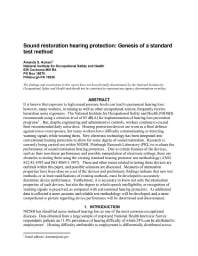Mining Publication: Sound Restoration Hearing Protection: Genesis of a Standard Test Method
Original creation date: July 2008
Authors: AS Azman
NIOSHTIC2 Number: 20034241
NOISE-CON 2008: Proceedings of the 2008 National Conference on Noise Control Engineering, Dearborn, Michigan, July 28-31, 2008. Burroughs C; Lim T; Kim J; Maling G; eds., Indianapolis, IN: Institute of Noise Control Engineering of the USA, 2008; :1-10
It is known that exposure to high sound pressure levels can lead to permanent hearing loss; however, many workers, in mining as well as other occupational sectors, frequently receive hazardous noise exposures. The National Institute for Occupational Safety and Health (NIOSH) recommends using a criterion level of 85 dB(A) for implementation of hearing loss prevention programs. But, despite engineering and administrative controls, workers continue to exceed their recommended daily noise dose. Hearing protection devices are worn as a final defense against noise overexposure, but many workers have difficulty communicating or detecting warning signals while wearing them. New electronic technology has been integrated into conventional hearing protectors to allow for some degree of sound restoration. Research is currently being carried out within NIOSH, Pittsburgh Research Laboratory (PRL) to evaluate the performance of sound restoration hearing protectors. Due to certain features of the devices, such as their non-linear performance and possible manipulation of electronic settings, there are obstacles to testing them using the existing standard hearing protector test methodology (ANSI S12.42-1995 and ISO 4869-3:1997). These and other issues related to testing these devices are outlined within this paper, and possible solutions are discussed. Measures of attenuation properties have been done on a set of the devices and preliminary findings indicate that new test methods, or at least modifications of existing methods, must be developed to accurately determine device performance. Furthermore, it is necessary to know not only the attenuation properties of such devices, but also the degree to which speech intelligibility or recognition of warning signals is preserved, as compared with conventional hearing protectors. As additional data is collected a more accurate and reliable test methodology will be developed, and a more comprehensive picture regarding device performance will be determined and disseminated.

NIOSHTIC2 Number: 20034241
NOISE-CON 2008: Proceedings of the 2008 National Conference on Noise Control Engineering, Dearborn, Michigan, July 28-31, 2008. Burroughs C; Lim T; Kim J; Maling G; eds., Indianapolis, IN: Institute of Noise Control Engineering of the USA, 2008; :1-10
- Analysis of a Mechanism Suspension to Reduce Noise from Horizontal Vibrating Screens
- Cross-Sectional Survey of Noise Exposure in the Mining Industry
- Determination of Sound Exposures (DOSES): Software Manual and Implementation Guide
- Noise and Hearing Protection: Development of Two Training Exercises for Drillers
- Noise Assessment of Stone/Aggregate Mines: Six Case Studies
- A Noise Control for A Roof Bolting Machine: Collapsible Drill Steel Enclosure
- Snapshot of Noise and Worker Exposures in Sand and Gravel Operations
- Technology News 536 - NIOSH Develops New Software to Analyze and Reduce Noise Exposure
- Water Well Safety Bits: Health And Safety Information For The Water Well Industry
- What Does a Hearing Loss Sound Like?